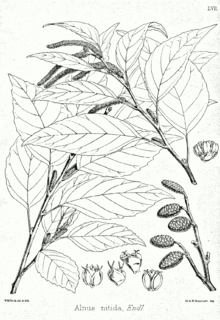Alnus nitida: Difference between revisions
Content deleted Content added
Added insect it hosts |
Added sentence about flowers |
||
| Line 13: | Line 13: | ||
}} |
}} |
||
'''''Alnus nitida''''', called the '''west Himalayan alder''', is a species in the genus ''[[Alnus]]'', native to Pakistan, the western Himalayas, and Nepal.<ref name="294962-1" >{{cite web |url=http://powo.science.kew.org/taxon/urn:lsid:ipni.org:names:294962-1 |title=''Alnus nitida'' (Spach) Endl. |author=<!--Not stated--> |date=2017 |website=Plants of the World Online |publisher=Board of Trustees of the Royal Botanic Gardens, Kew |access-date=21 December 2020 }}</ref> It is a tree reaching 20 to 25{{nbsp}}m, preferring to live along the banks of rivers. It is used locally for timber and firewood, and as a [[street tree]].<ref>{{cite journal |title=Genetic diversity in threatened plant species ''Alnus nitida'' (Spach.) Endel |year=2020 |last1=Khan |first1=Muhammad Khalil Ullah |last2=Muhammad |first2=Noor |last3=Uddin |first3=Nisar |last4=Ali |first4=Niaz |last5=Umer |first5=Muhammad |last6=Ullah |first6=Shariat |journal=Plant Science Today |volume=7 |issue=3 |pages=314–318 |doi=10.14719/pst.2020.7.3.759 |doi-access=free }}</ref> It grows well in heavy, clay soils and tolerates infertile soils.<ref>{{Cite web|title=Alnus nitida - Useful Temperate Plants|url=http://temperate.theferns.info/plant/Alnus+nitida|access-date=2021-05-03|website=temperate.theferns.info}}</ref> The leaves are thin, oval to ovate, 3-6 inches long and 2-3 inches wide.<ref>{{Cite web|title=Alnus nitida - Trees and Shrubs Online|url=https://treesandshrubsonline.org/articles/alnus/alnus-nitida/|access-date=2021-05-03|website=treesandshrubsonline.org}}</ref> |
'''''Alnus nitida''''', called the '''west Himalayan alder''', is a species in the genus ''[[Alnus]]'', native to Pakistan, the western Himalayas, and Nepal.<ref name="294962-1" >{{cite web |url=http://powo.science.kew.org/taxon/urn:lsid:ipni.org:names:294962-1 |title=''Alnus nitida'' (Spach) Endl. |author=<!--Not stated--> |date=2017 |website=Plants of the World Online |publisher=Board of Trustees of the Royal Botanic Gardens, Kew |access-date=21 December 2020 }}</ref> It is a tree reaching 20 to 25{{nbsp}}m, preferring to live along the banks of rivers. It is used locally for timber and firewood, and as a [[street tree]].<ref>{{cite journal |title=Genetic diversity in threatened plant species ''Alnus nitida'' (Spach.) Endel |year=2020 |last1=Khan |first1=Muhammad Khalil Ullah |last2=Muhammad |first2=Noor |last3=Uddin |first3=Nisar |last4=Ali |first4=Niaz |last5=Umer |first5=Muhammad |last6=Ullah |first6=Shariat |journal=Plant Science Today |volume=7 |issue=3 |pages=314–318 |doi=10.14719/pst.2020.7.3.759 |doi-access=free }}</ref> It grows well in heavy, clay soils and tolerates infertile soils.<ref>{{Cite web|title=Alnus nitida - Useful Temperate Plants|url=http://temperate.theferns.info/plant/Alnus+nitida|access-date=2021-05-03|website=temperate.theferns.info}}</ref> The leaves are thin, oval to ovate, 3-6 inches long and 2-3 inches wide.<ref>{{Cite web|title=Alnus nitida - Trees and Shrubs Online|url=https://treesandshrubsonline.org/articles/alnus/alnus-nitida/|access-date=2021-05-03|website=treesandshrubsonline.org}}</ref> Female [[Flower|flowers]] appear first, followed by male [[Catkin|catkins]] in September to October, which may be up to 19 centimeters long.<ref>{{Cite web|title=Alnus nitida in Flora of Pakistan @ efloras.org|url=http://www.efloras.org/florataxon.aspx?flora_id=5&taxon_id=242420274|access-date=2021-05-03|website=www.efloras.org}}</ref> |
||
This tree may be attacked by the apple stem borer (''Trirachys holosericeus'').<ref>{{Cite web|title=Alnus nitida (West Himalayan alder)|url=https://www.cabi.org/isc/datasheet/4588|access-date=2021-05-03|website=www.cabi.org}}</ref> |
This tree may be attacked by the apple stem borer (''Trirachys holosericeus'').<ref>{{Cite web|title=Alnus nitida (West Himalayan alder)|url=https://www.cabi.org/isc/datasheet/4588|access-date=2021-05-03|website=www.cabi.org}}</ref> |
||
Revision as of 10:34, 3 May 2021
| Alnus nitida | |
|---|---|

| |
| Botanical illustration | |
| Scientific classification | |
| Kingdom: | Plantae |
| Clade: | Tracheophytes |
| Clade: | Angiosperms |
| Clade: | Eudicots |
| Clade: | Rosids |
| Order: | Fagales |
| Family: | Betulaceae |
| Genus: | Alnus |
| Species: | A. nitida
|
| Binomial name | |
| Alnus nitida | |
| Synonyms[3] | |
|
Clethropsis nitida Spach | |
Alnus nitida, called the west Himalayan alder, is a species in the genus Alnus, native to Pakistan, the western Himalayas, and Nepal.[3] It is a tree reaching 20 to 25 m, preferring to live along the banks of rivers. It is used locally for timber and firewood, and as a street tree.[4] It grows well in heavy, clay soils and tolerates infertile soils.[5] The leaves are thin, oval to ovate, 3-6 inches long and 2-3 inches wide.[6] Female flowers appear first, followed by male catkins in September to October, which may be up to 19 centimeters long.[7]
This tree may be attacked by the apple stem borer (Trirachys holosericeus).[8]
References
- ^ Shaw, K., Roy, S. & Wilson, B. (2014). "Alnus nitida". IUCN Red List of Threatened Species. 2014: e.T194659A2356455. doi:10.2305/IUCN.UK.2014-3.RLTS.T194659A2356455.en. Retrieved 3 May 2021.
{{cite journal}}: CS1 maint: multiple names: authors list (link) - ^ Gen. Pl., Suppl. 4(2): 20 (1847)
- ^ a b "Alnus nitida (Spach) Endl". Plants of the World Online. Board of Trustees of the Royal Botanic Gardens, Kew. 2017. Retrieved 21 December 2020.
- ^ Khan, Muhammad Khalil Ullah; Muhammad, Noor; Uddin, Nisar; Ali, Niaz; Umer, Muhammad; Ullah, Shariat (2020). "Genetic diversity in threatened plant species Alnus nitida (Spach.) Endel". Plant Science Today. 7 (3): 314–318. doi:10.14719/pst.2020.7.3.759.
- ^ "Alnus nitida - Useful Temperate Plants". temperate.theferns.info. Retrieved 2021-05-03.
- ^ "Alnus nitida - Trees and Shrubs Online". treesandshrubsonline.org. Retrieved 2021-05-03.
- ^ "Alnus nitida in Flora of Pakistan @ efloras.org". www.efloras.org. Retrieved 2021-05-03.
- ^ "Alnus nitida (West Himalayan alder)". www.cabi.org. Retrieved 2021-05-03.

